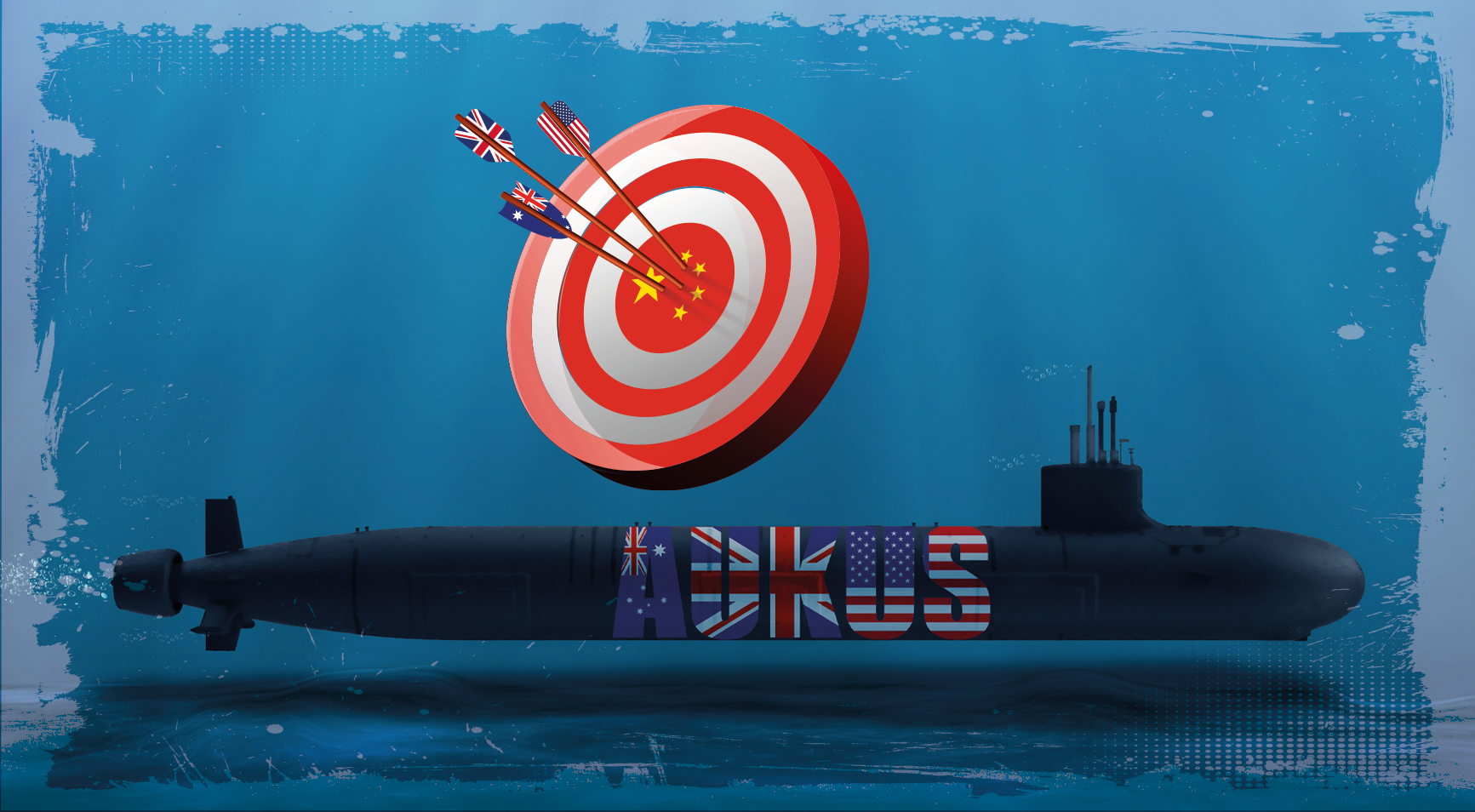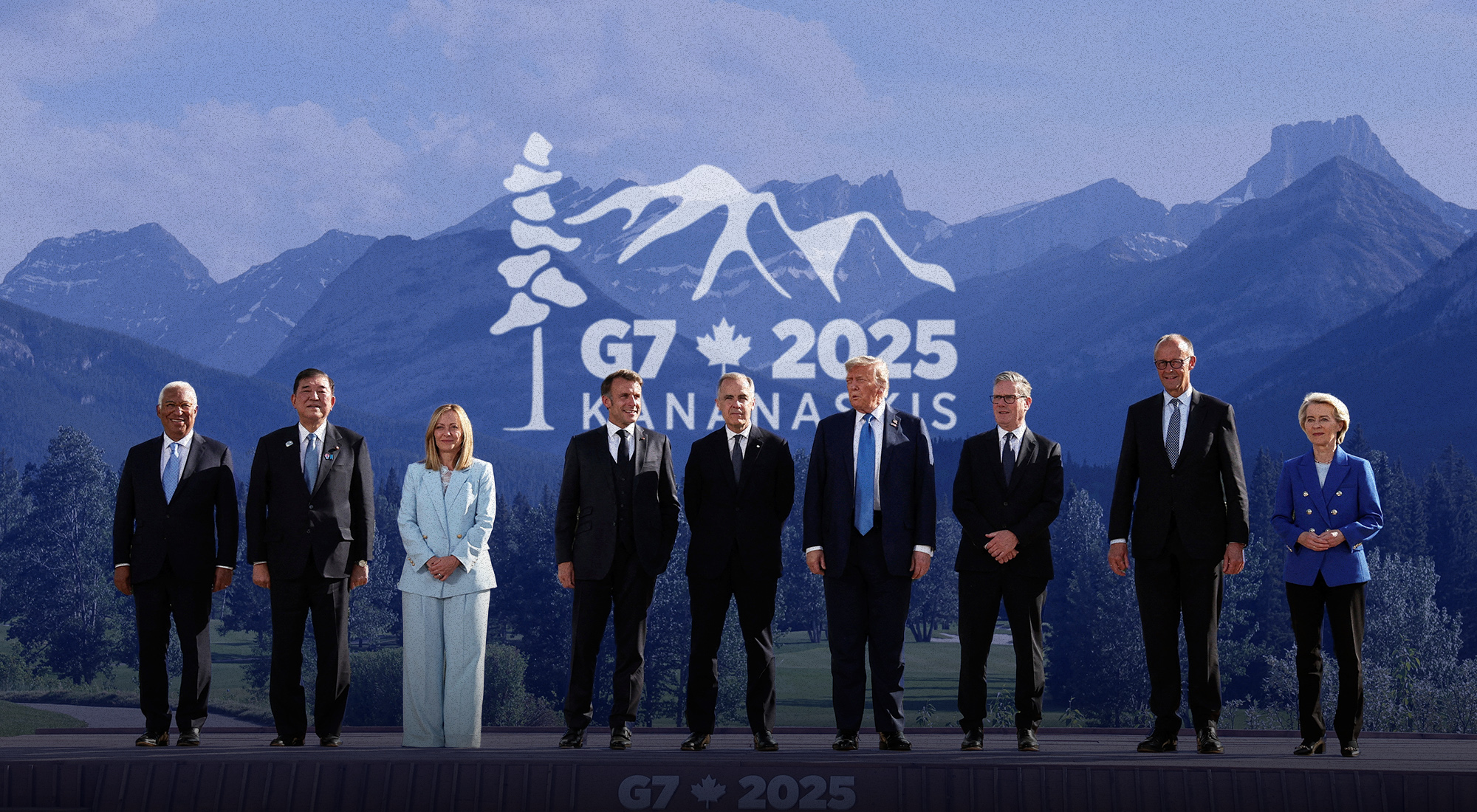On 15 September, US President Joe Biden, speaking alongside Australia’s Prime Minister Scott Morrison and UK Prime Minister Boris Johnson, announced the creation of a new strategic alliance involving the three countries and codenamed AUKUS.[1] This partnership will pave the way towards greater intelligence-sharing and interoperability between the armed forces of the three countries. Among the numerous items on the agenda of military cooperation is one major project involving the US delivering a fleet of nuclear-powered submarines to Australia. The transfer of such sensitive technology constitutes an unprecedented move from one nuclear-armed country to a non-nuclear-armed one and evidences the supreme importance conferred by Washington to the trilateral arrangement.
Since its disclosure, AUKUS has generated enthusiastic comments as well as fierce opposition. Noticeably, China condemned the new agreement as an antagonistic partnership designed to contain its expansion. But it also generated significant friction among traditional Western allies as France found itself blindsided by the announcement. Back in 2016, French shipbuilding company Naval Group had been awarded the development of conventional submarines by Australia and both the French government and the company leadership discovered on the morning of that 15 September that their contract was de facto cancelled.
But it is worth going beyond the razzmatazz of the diplomatic crisis between Washington and Paris to question the strategic significance of AUKUS. This new framework does not exactly represent a shift from past practices in US policy towards the Indopacific: historically, it builds on the legacy of previous frameworks such as the ANZUS Treaty (including New Zealand too) or the “Five Eyes” intelligence arrangements. But at the same time, AUKUS provides us with a clear snapshot of the underlying currents in the region. Specifically, it reflects how much Australian and British perceptions of China have changed in the past decade. It highlights elements of continuity between the Biden administration and the previous ones while confirming the new priority conferred to the Indopacific vis-à-vis other regions such as the Middle East and Europe.
At the same time, the reactions triggered by AUKUS, be it in Beijing, Delhi, Kuala Lumpur, Jakarta, or Paris tell us also how the pact has profound implications for the way we are to conceive the future of an Indopacific security architecture. In other words, AUKUS not only dismisses the European aspirations to play a role in the area, but it sends a strong signal across the Indopacific to the smaller states, in particular those in Southeast Asia, that the days of nonalignment and benign neutrality with regards to the US-China competition are gone.
The strategic trajectory of Australia and the UK
One of the most important messages signaled by AUKUS relates to the way both Canberra and London have moved from their previous caution regarding the US-China competition to embrace the view from Washington. Both did so in different ways and for different reasons.
Australia’s decision can be seen as the result of a decade of increased tensions between Canberra and Beijing. It is a major departure from the decision, back in 2007, of Prime Minister Rudd to withdraw Australia from the initial Quadrilateral Security Dialogue (QUAD) that gathered India, Japan and the US. At that time, Canberra felt unease with a US-led forum that clearly antagonized China and considered that its membership could affect Australian security interests. But since then, the calculus changed. Diplomatic relations between Australia and China have been significantly degraded and the subsequent strategy documents released by the Australian government conveyed growing concerns on China’s rise and its impact on Australia’s defense policy. These last months, the strained relationship between both countries was in full display as China imposed economic sanctions on Australian companies because of Canberra’s criticism of Chinese management of the Covid-19 pandemic.
Starting in the 2010s, these tensions led to an explicit rapprochement between Australia with countries like India and France. Indeed, the decision in 2016 to select French Naval Group for the production of 12 attack diesel submarines translated the desire of Canberra to strengthen the ability of its navy in light of the Chinese maritime assertiveness. But the biggest indicator of Australia’s changed calculus was undoubtedly the expansion of Australia’s military cooperation with the US, starting with the deployment of a US Marine Rotational Force in Darwin in late 2011. This was accompanied by US major arms sales such as the purchase of 72 F-35 fighters and 15 P-8A Poseidon anti-submarine warfare aircraft.
The UK also changed its assessment of China’s rise. Until recently, London was adamant about keeping strong economic ties with China, as it represents the second largest destination for Chinese investments in Europe after Germany. This had led the UK to accommodate Beijing’s growing presence in its markets, even in sensitive sectors. For instance, the successive governments of Tony Blair, David Cameron and Theresa May signed off on a project to build a local nuclear plant involving China General Nuclear (CGN). This changed, however, when London announced in July 2020 its intention to review the program without the involvement of CGN.[2]
London’s position on the issue of granting Huawei access to the UK’s 5G network followed a similar pattern. At first, British officials dismissed American demands to ban the Chinese company. The then-Foreign Secretary Jeremy Hunt argued in speeches that Washington “doesn’t have a veto” on British policy. But eventually Prime Minister Boris Johnson backtracked in the first half of 2020 and ordered British firms to remove all Huawei equipment from its 5G network by 2027.[3]
Like in Australia, these measures followed a change in British foreign policy orientation towards China and an alignment on US views. If the UK Strategic Defence and Security Review of 2015 depicted China as a “partner”, its Integrated Review in 2021 is now calling it a “systemic competitor”. It was also followed by a UK decision to “tilt” towards the Indopacific that mirrored the US agenda for the region.[4] This new orientation was then compounded by the attitude of London regarding the protracted crisis in Hong-Kong that arose in the fall of 2019. In response to Beijing’s tightening grip over the former British colony, the British government initiated in January 2021 a fast-track immigration program specifically for Hong-Kong citizens fearing the worsening of Chinese control over the city.
As a result, AUKUS is first a confirmation regarding the revised calculus of two of the closest allies of Washington. From that perspective, it could be seen as the culmination point of a regional realignment caused by China’s expansion and that has been in the making for the past decade.
The first foreign policy achievement of US President Biden
The surprised announcement of AUKUS also reaffirmed the Indopacific as the ultimate priority of the new US administration. Timing matters as the declaration came only weeks after the calamitous withdrawal of American troops from Afghanistan, which turned the page of the 20-year war on terror. In this context, the new agreement can arguably be seen as the first true foreign policy achievement of the Biden presidency.
In many ways, this is an achievement that builds on the work of previous administrations. One of the main architects of the agreement was Kurt Campbell, the coordinator for the Indopacific at the National Security Council, who was already instrumental in designing Barack Obama’s pivot to Asia at the time when he was assistant secretary of state for East Asian and Pacific Affairs. It was also the Obama administration that negotiated the increased presence of US Marines at Darwin naval base in West Australia back in 2011.
The Biden policy also prolongs the decision of the Trump presidency to refocus attention and resources to the Indopacific and to strengthen partnerships in the area. As a matter of fact, it was under Donald Trump’s mandate that the Quad framework was revived in 2017. Moreover, declassified materials from that period underline the priority assigned to the strengthening of military cooperation with Australia.[5]
The one major novelty with AUKUS relates to its nuclear dimension. The US decision to explore ways to deliver sensitive technology such as nuclear-powered submarines reveals not only the current level of trust between Washington and Canberra but also the long-term horizon under which the partnership is operating: given the complexity of building nuclear-powered submarines, the delivery date is likely to be after 2040.
At an operational level, nuclear-powered submarines will provide the Australian fleet with greater endurance than would have been possible with the French platforms. But at the same time, it causes unease among nonproliferation specialists who now fear that such technology transfer could undermine international efforts to prevent the use of nuclear technology for military purpose.[6] Noticeably, this controversy around AUKUS recalls the US decision, back in 2005, to sign a civilian nuclear cooperation agreement with India that also heralded the new Washington-Delhi partnership while triggering concerns over nonproliferation norms.
Lastly, AUKUS can be understood as a steppingstone of the Biden approach towards the Indopacific. It projects the desire of the new administration to build new security arrangements in order to shape the governance of the broader region. It is telling that the creation of this trilateral pact was followed ten days later by the first “in-person” summit of the Quad in Washington. The rhetoric used by officials during both events were in many ways identical. Just like during the press conference held by Biden, Johnson, and Morrison, the joint statement at the end of the Quad meeting emphasized the promotion of “the free, open, rules-based order (…) in the Indo-Pacific”.[7] This happened also to be the wording used by the Trump administration in its official documents such as its Indopacific Strategy of 2019. Consequently, it can be anticipated that from now on, both the Quad and AUKUS will serve as the two legs of US regional diplomacy.
The regional effects of AUKUS
Because AUKUS is likely to alter the political dynamics in the Indopacific, all the regional stakeholders were forced to react to its revelation, though their attitude greatly varied. At the regional level, AUKUS confirms the underlying currents in the Indopacific, namely the increased polarization of the area between the US and China, but such logic does not benefit everyone.
Japan has officially expressed its support for the initiative led by Washington, London, and Canberra seeing such reinforcement of military ties as complementary to its own agenda. India – whose prime minister Modi held talks with US President Biden only days after the AUKUS announcement – has been relatively less vocal, but clearly sees all efforts to balance against China as being in its own interest too.[8]
But other states in Asia were less pleased with the idea that when push comes to shove, they may have to choose between Washington and Beijing. This is unlikely to be an easy dilemma for those countries that so far tried to avoid as much as possible aligning themselves on the position of the two great powers. For instance, Southeast Asian countries have cautiously kept their distances from these developments. Malaysia’s Prime Minister Ismail Sabri Yaakob described AUKUS as a “catalyst for a nuclear arms race in the Indo-pacific region”.[9] Indonesian authorities similarly expressed concerns over the aggressive undertone of AUKUS for regionals stability.
Meanwhile in Beijing, the announcement of AUKUS was logically met with negative reactions from the Chinese government. China’s Foreign Ministry spokesperson Zhao Lijian dismissed the agreement as reflecting an “outdated Cold War zero-sum mentality and narrow-minded geopolitical perception”.[10] Zhao warned against the practice of “small cliques’ politics” that AUKUS and Quad meetings illustrated.[11] The Chinese government also suggested that the provision of nuclear-powered submarines to Australia would violate Canberra’s commitment under the Treaty of Rarotonga, although the document prohibits nuclear weapons, not nuclear technology.
It is worth noting that two days after the AUKUS declaration, ten planes of the Chinese Air Force entered Taiwan air defense zone while a US destroyer crossed the Taiwan Strait – a “routine” passage through international waters. While the event was not unprecedented and by no means was triggered by the new alliance framework, the concomitance of these two events evidenced the level of tensions on both sides.
Interestingly, one of China’s reactions to AUKUS involved its surprising application to the Comprehensive and Progressive Trans-Pacific Partnership (CPTPP), a trade agreement initially negotiated by President Obama to counter China’s economic clout in the region. The US left the CPTPP in 2017 following a decision by then President Donald Trump to pull the country out. Beijing’s move towards this Asian economic partnership is unlikely to succeed: all 11 signatory states would have to approve its membership, and the list includes some countries with contentious relations with China (such as Canada, Japan, and Australia). The Chinese bid has been read as political posturing that aimed to highlight the US absence from the CPTPP, and possibly drive a wedge among Washington’s regional partners.[12]
But arguably, it was less China than France that reacted with the most vigorous protests against AUKUS. In the past decade, France had designed its own Indopacific strategy relying primarily on two local partnerships, namely with India and Australia. As mentioned earlier, the latter had chosen France’s Naval Group to build a conventional submarine fleet back in 2016. Even though delays and cost overruns were already overshadowing the deal, no one in Paris apparently expected its brutal termination.
Beyond the industrial loss, government officials in Paris felt humiliated by the secrecy that preceded the AUKUS revelation. In his first statements, French Foreign Minister Jean-Yves Le Drian accused counterparts in Washington and Canberra of lies and deception. France then escalated by recalling its ambassadors from the US and Australia – an unprecedented measure among these allied countries.
The diplomatic tensions between both sides of the Atlantic were compounded by the fact that the White House revealed the existence of its new trilateral pact the exact same day that the European Union released its own Indo-Pacific Strategy document. This awkward timing further fueled the perception that the US, by design or by neglect, had sidelined not just France, but also the Europeans as a whole, from its Indopacific strategy – even though the Biden administration, like its predecessor, had repeatedly called for greater European contribution to the region.
This transatlantic dispute may not fade away easily, as it reopens deep scars between Washington and Paris. It revives the old French sentiment of isolation from the Anglosphere, already visible with the “Five Eyes” framework, and which AUKUS is now starkly crystallizing. More problematic, it could feed the platform of populist parties in Europe calling for a rejection of transatlantic ties.
But when the dust settles, France will keep its role as a middle power in the Indopacific, or as French officials like to say, a “resident power” that shares a maritime border with Australia thanks to New Caledonia. But at the same time, the transatlantic dispute over AUKUS might reinforce the views among European countries such as Germany or Italy that the Indopacific is and will remain an American affair with no direct relevance for their own national interests.
All in all, future historians might look back at AUKUS as a milestone in the new chapter of US foreign policy that followed the 20-year war against terror. After years of talk of a disengagement from the Middle East and of a pivot to Asia, both the reactivation of the Quad and the creation of AUKUS may be finally opening the Indopacific chapter of US strategy.
References
[1] “Remarks by President Biden, Prime Minister Morrison of Australia, and Prime Minister Johnson of the United Kingdom Announcing the Creation of AUKUS”, US White House, 15 September 2021. https://www.whitehouse.gov/briefing-room/speeches-remarks/2021/09/15/remarks-by-president-biden-prime-minister-morrison-of-australia-and-prime-minister-johnson-of-the-united-kingdom-announcing-the-creation-of-aukus/
[2] Jillian Ambrose, “China’s nuclear power firm could be blocked from UK projects”, 26 July 2021, The Guardian. https://www.theguardian.com/environment/2021/jul/26/chinas-nuclear-power-firm-could-be-blocked-from-uk-projects
[3] “Britain bans new Huawei 5G kit installation from September 2021”, Reuters, 30 November 2020. https://www.reuters.com/article/us-britain-huawei-idUSKBN28A005
[4] Rahul Roy-Chaudhury, “Understanding the UK’s ’tilt’ towards the Indo-Pacific”, International Institute for Strategic Studies, 15 April 2021. https://www.iiss.org/blogs/analysis/2021/04/uk-indo-pacific-tilt
[5] See National Security Council Document No.000174, “U.S. Strategic Framework for the Indo-Pacific”, Declassified on 5 January 2021. https://trumpwhitehouse.archives.gov/wp-content/uploads/2021/01/IPS-Final-Declass.pdf
[6] George Moore, Frank Von Hippel, “Nuclear subs in Australia will challenge the nonproliferation regime, and China”, The Hill, 22 September 2021. https://thehill.com/opinion/international/573441-nuclear-subs-down-under-will-challenge-the-nonproliferation-regime-and
[7] Steve Holland, David Brunnstrom, Nandita Bose, Michael Martina, “Quad leaders press for free Indo-Pacific, with wary eye on China”, Reuters, 25 September 2021.
[8] C. Raja Mohan, “AUKUS, the Quad, and India’s Strategic Pivot”, Foreign Policy, 23 September 2021.
[9] Sebastian Strangio, “Malaysia to Seek Chinese ‘Views’ on New AUKUS Security Pact”, The Diplomat, 24 September 2021. https://thediplomat.com/2021/09/malaysia-to-seek-chinese-views-on-new-aukus-security-pact/
[10] Phelim Kine, “China howls at perceived threat of new ‘AUKUS’ agreement”, Politico, 16 September 2021.
[11] “China warns against ‘small cliques’ politics as ‘Quad’ leaders to meet”, CGTN, 14 September 2021. https://news.cgtn.com/news/2021-09-14/China-warns-against-small-cliques-politics-as-Quad-leaders-to-meet-13yifKdlQ08/index.html
[12] Peter Landers, Stephen Wright, “China’s Bid to Join TPP Trade Group Puts Members in an Awkward Spot”, Wall Street Journal, 17 September 2021.








